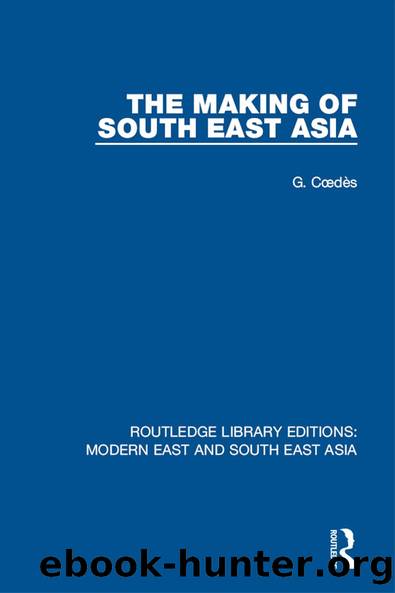The Making of South East Asia (RLE Modern East and South East Asia) by George Coedes

Author:George Coedes [Coedes, George]
Language: eng
Format: epub
ISBN: 9781138901407
Barnesnoble:
Publisher: Taylor & Francis
Published: 2016-11-09T00:00:00+00:00
XIII. SIAMESE SCULPTURE: Left: Statue of the Buddha of the school of Sukhodaya (13th c.). Right: Statue of the Buddha of the school of U Thong (13th c.).
XIV. SIAMESE ARCHITECTURE.
When Narayana fell ill in 1688, the dignitaries of State got him to appoint Bedraja as regent. Bedraja had the Greek adventurer arrested and executed on 5 June 1688, and mounted an attack against the French in the fort of Bangkok, who held out. On 11 July 1688 Narayana died, and Bedraja was immediately proclaimed king. The new reign began with a certain amount of persecution of Catholics and French nationals. The soldiers of the Bangkok garrison managed to withdraw to Pondicherry, but during the years that followed the Jesuitsâ efforts to negotiate a new treaty met with no success. This marked the end of French influence in Siam, and indeed the beginning of the decline of European influence as a whole, despite the conclusion of a new treaty with Holland renewing the privileges previously granted.
Largely owing to the Burmese wars, there had been an eclipse of literary activities, but the reign of Narayana is considered to be the golden age of Siamese poetry. The king â himself a poet â was surrounded by talented writers who created new forms which were much admired. Four poetical works are attributed to the king himself: the translation of the middle part of the Samuddhaghosa â one of the Fifty (apocryphal) Jataka â which had been begun by Maharajaguru and was completed at the beginning of the nineteenth century by Prince Paramanujita Jinorasa; and three moralistic pieces: the Instructions of Valin to his younger brother (Sugriva), the Instructions of Dasaratha to Rama, each based on an episode from the Ramayana, and lastly Rajasvasti. He is also supposed to have been the author of the Pâra Lo, one of the chefsdâÅuvre of Siamese literature; but this poem in varied metre (of the lilit type) may date back to the beginning of the seventeenth century. The theme of the poem is similar to that of Romeo and Juliet, with which it has been compared. It is about a young prince and two princesses who are crossed in love because of family feuds. The most celebrated among the writers of this reign are: Maharajaguru, to whom is attributed the first part of the verse translation of the Samuddhaghosa, and the translation of the Gavi, another of the Fifty Jataka, as well as a work on grammar and poetic composition entitled Chintamani; Shri Prajna (Si Prat), who was possibly the son of the foregoing â a precocious young poet who led a hectic life at Court and was finally executed as a result of amorous intrigues, and whose output, apart from his poem Aniruddha, consisted chiefly of very short occasional poems, madrigals, and verses with set rhymes based on a theme taken from a line of one or other of the kingâs poems; Shri Mahoshadha (Si Mahosot), who wrote artificial verse and a eulogy of the king; and
Download
This site does not store any files on its server. We only index and link to content provided by other sites. Please contact the content providers to delete copyright contents if any and email us, we'll remove relevant links or contents immediately.
The Sympathizer by Viet Thanh Nguyen(4344)
The Rape of Nanking by Iris Chang(4170)
World without end by Ken Follett(3446)
Ants Among Elephants by Sujatha Gidla(3442)
Blood and Sand by Alex Von Tunzelmann(3168)
Japanese Design by Patricia J. Graham(3139)
The Queen of Nothing by Holly Black(2546)
City of Djinns: a year in Delhi by William Dalrymple(2533)
Foreign Devils on the Silk Road: The Search for the Lost Treasures of Central Asia by Peter Hopkirk(2445)
India's Ancient Past by R.S. Sharma(2433)
Inglorious Empire by Shashi Tharoor(2414)
Tokyo by Rob Goss(2408)
In Order to Live: A North Korean Girl's Journey to Freedom by Yeonmi Park(2362)
Tokyo Geek's Guide: Manga, Anime, Gaming, Cosplay, Toys, Idols & More - The Ultimate Guide to Japan's Otaku Culture by Simone Gianni(2346)
India's biggest cover-up by Dhar Anuj(2337)
The Great Game: On Secret Service in High Asia by Peter Hopkirk(2318)
Goodbye Madame Butterfly(2231)
Batik by Rudolf Smend(2155)
Living Silence in Burma by Christina Fink(2049)
